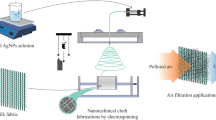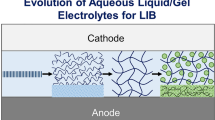Abstract
A bioactive and non-toxic biopolymer-based electrolyte has gained attention in recent research for their potential applications in the fabrication of electrochemical devices. In this work, we extracted the chitosan successfully prepared from shrimp shells using Brine’s method. The solid polymer electrolyte comprising the blend of chitosan and agar–agar, plasticised with polyethylene glycol (PEG), as host polymer and lithium perchlorate (LiClO4) as a dopant is prepared by solution casting technique. Also, the effect of different weight percentage of the plasticiser PEG at a fixed ratio of perchlorate content is investigated. The obtained chitosan blended film is highly suitable as a electrolyte for electrochemical devices. The prepared polymer electrolyte is characterised using attenuated total reflection–Fourier transform infrared spectroscopy (ATR–FTIR), high-resolution scanning electron microscopy (HR–SEM), X-ray diffraction (XRD) and electrochemical impedance spectroscopy. The ATR–FTIR spectroscopy confirms the presence of particular functional groups present in chitosan and complex formation between blended polymers and lithium perchlorate. The surface morphology and amorphous crystallinity of chitosan and blended polymer electrolytes revealed from HR–SEM and XRD analysis. The ionic conductivity of the prepared materials is studied using AC impedance spectroscopy and compared. The highest ionic conductivity at room temperature obtained for the sample is 4.56 × 10−4 Scm−1 (CAP3). The mechanical properties of films have been studied using a Universal testing machine analysis. Wagner’s polarisation measurements have estimated the Li+ transport numbers of SPEs. Linear sweep voltammetry was performed on half-cell method to study the electrochemical stability window of the maximum ionic conductivity of SPEs.












Similar content being viewed by others
References
Bouhenna M, Salah R, Bakour R, Drouiche N, Abdi N, Grib H, Lounici H, Mameri, (2015) Effect of chitin and its derivatives on human cancer cells lines. Environ SciPollut Res 22:15579–15586. https://doi.org/10.1007/s11356-015-4712-3
Ahmed TA, Aljaeid BM (2016) Preparation, characterisation, and potential application of chitosan, chitosan derivatives, and chitosan metal nanoparticles in pharmaceutical drug delivery. Drug Des Dev Ther 10:483–507. https://doi.org/10.2147/DDDT.S99651
Agronomy SRG (2013) A review of the applications of chitin and its derivatives in agriculture to modify plant-microbial. Interact Improv Crop Yields 3:757–793. https://doi.org/10.3390/agronomy3040757
No LHK, Meyers SP (2000) Application of chitosan for treatment of wastewaters. Environ ContamToxicol 1:1–27. https://doi.org/10.1007/978-1-4757-6429-11
Abreha Merhawi, Purushotham Gebreyesus (2016) Preparation and characterisation of lithium ion conducting polymer electrolytes based on a blend of poly(vinylidene fluoride-co-hexafluoropropylene) and poly(methyl methacrylate). Heliyon 2:7. https://doi.org/10.1016/j.heliyon.2016.e00134
PradeepaPrabakaran RP, Gurusamy MS, EdwinrajSebasthiyan, (2017) Plasticized polymer electrolyte membranes based on PEO/PVdF-HFP for use as an effective electrolyte in lithium-ion batteries. Chin J PolymSci 35(3):407–421. https://doi.org/10.1007/s10118-017-1906-9
Wei Z, Chen S, Wang J, Wang Z, Zhang Z (2018) Superior lithium ion conduction of polymer electrolyte with comb-like structure via solvent-free copolymerisation for bipolar all-solid-state lithium battery. J Mater Chem 6:13438–13447. https://doi.org/10.1039/C8TA04477E
Wang Z, Gu Hui, Wei Zhenyao (2018) Preparation of new composite polymer electrolyte for long cycling all-solid-state lithium battery. Ionics 25:907–916. https://doi.org/10.1007/s11581-019-02852-6
Wang Furi, Li Libo, Yang Xueying, You Jun (2018) Influence of additives in a PVDF-based solid polymer electrolyte on conductivity and Li-ion battery performance. Sust Energy Fuels. https://doi.org/10.1039/C7SE00441A
Selvalakshmi S, Vijaya N, Selvasekarapandian S, Premalatha M (2017) Biopolymer agar-agar doped with NH4SCN as solid polymer electrolyte for electrochemical cell application. J ApplPolymSci 1–10:44702. https://doi.org/10.1002/app.44702
Ramesh S, Shanti R, Morris E (2012) Plasticising effect of 1-allyl-3-methlyimidazolium chloride in cellulose acetate based polymer electrolytes. CarbohydPolym 87:2624–2629. https://doi.org/10.1016/j.carbpol.2011.11.037
Yusof YM, Kadir MFZ (2016) Electrochemical characterisations and the effect of glycerol in biopolymer electrolytes based on methylcellulose-potato starch blend. MolCrystLiqCryst 627(1):220–233. https://doi.org/10.1080/15421406.2015.1137115
Liew CW, Ramesh S (2015) Electrical, structural, thermal and electrochemical properties of corn starch-based biopolymer electrolytes. CarbohydrPolym 124:222–228. https://doi.org/10.1016/j.carbpol.2015.02.024
Aziz SB, Hamsan MH, Abdullah RM (2019) A promising polymer blend electrolytes based on chitosan: methyl cellulose for EDLC application with high specific capacitance and energy density. MDPI Mol 24:2503. https://doi.org/10.3390/molecules24132503
Salman YAK, Abdullah O (2018) Conductivity and electrical properties of chitosan: methylcellulose blend biopolymer electrolyte incorporated with lithium tetrafluoroborate. Int J ElectrochemSci 13:3185–3199. https://doi.org/10.20964/2018.04.25
Sudhakar YN, Selvakumar M, Krishna Bhat D (2013) LiClO4-doped plasticised chitosan and poly(ethylene glycol) blend as biodegradable polymer electrolyte for supercapacitors. Ionics 19:277–285. https://doi.org/10.1007/s11581-012-0745-5
Rathod SG, Bhajantri RF, Ravindrachary V, Poojary B, Pujari PK (2016) Influence of transport parameters on conductivity of lithium perchlorate-doped poly(vinyl alcohol)/chitosan composites. J ElastomPlast. https://doi.org/10.1177/0095244315580457
Negrea P, Caunii A, Sarac I, Butnariu M (2015) The study of infrared spectrum of chitin and chitosan extract as potential sources of biomass. Dig J NanomaterBiostruct 4:1129–1138
Dilyana, Zvezdova (2010) Investigation of some physicochemical properties of chitin from crab shells HAУЧHИ TPУДOBE HA PУCEHCКИЯ УHИBEPCИTET , тoм 49, cepия 9
Sim LH, Gan SN, Chan CH, Yahya R (2010) ATR-FTIR studies on ion interaction of lithium perchlorate in polyacrylate/poly(ethylene oxide) blends. SpectrochimActa 76:287–292. https://doi.org/10.1016/j.saa.2009.09.031
Rumengan IFM, Suryanto E, Modaso R, Wullur S, Tallei TE, Limbong D (2014) Structural characteristics of chitin and chitosan isolated from the biomass of cultivated rotifer, Brachionusrotundiformis. Int J Fish AquatSci 3(1):12–18
Junga MR, David Horgena F, Orskib SV, Rodriguez V, C.b, Kathryn L. BeersbMarine, (2018) Validation of ATR FT–IR to identify polymers of plastic marine debris, including those ingested by marine organisms. Pollut Bull 127:704–716. https://doi.org/10.1016/j.marpolbul.2017.12.061
SamanehSaber-Samandari Mustafa Gazi Elvan Yilmaz (2012) UV-induced synthesis of chitosan-g-polyacrylamide semi-IPN superabsorbent hydrogels. Polym Bull 68:1623–1639. https://doi.org/10.1007/s00289-011-0643-4
Gutha Y, Pathak JL (2017) Antibacterial and wound healing properties of chitosan/poly(vinyl alcohol)/zinc oxide beads (CS/PVA/ZnO). Int J BiolMacromol. https://doi.org/10.1016/j.ijbiomac.2017.05.020
AygulKucukgulmez MC, YasemenYanar DS, HurriyetPolat EslemKadak (2011) Physicochemical characterisation of chitosan extracted from Metapenaeusstebbingi shells. Food Chem 126:1144–1148. https://doi.org/10.1016/j.foodchem.2010.11.148
Ibitoye EB, Lokman IH, Hezmee MN, Goh YM, Zuki Z, Jimoh AA (2018) Extraction and physicochemical characterization of chitin and chitosan isolated from house cricket. Biomed Mater 13(2):025009. https://doi.org/10.1088/1748-605X/aa9dde
Pradhan DK, Samantaray BK, Choudhary RNP, Karan NK, Thomas R, Katiyar RS (2007) Effect of plasticiser on structural and electric properties of polymer nanocomposite electrolytes. Int J ElectrochemSci 2:861–871. https://doi.org/10.1007/s11581-010-0491-5
Salman YA, Abdullah OG, Hanna RR, Aziz SB (2018) Conductivity and electrical properties of chitosan: methylcellulose blend biopolymer electrolyte incorporated with lithium tetrafluoroborate. Int J ElectrochemSci 13:3185–3199. https://doi.org/10.20964/2018.04.25
Rathod SG, Bhajantri RF, Ravindrachary V, BojaPoojary PK, Pujari TS, Naik J (2015) Influence of transport parameters on conductivity of lithium perchlorate-doped poly(vinyl alcohol)/chitosan composites. J Elastomers Plast. https://doi.org/10.1177/0095244315580457
Boudouaia N, Bengharez Z, Jellali S (2019) Preparation and characterisation of chitosan extracted from shrimp shells waste and chitosan film: application for Eriochrome black T removal from aqueous solutions. Appl Water Sci 9:91. https://doi.org/10.1007/s13201-019-0967-z
Ling-haoHea RX, Yanga D-B, Liua Y, Son R (2009) Effects of blending chitosan with peg on surface morphology, crystallisation and thermal properties. Chin J PolymSci 27(4):501–510
Bhoopathi G, Nithya N, Arun AP, Ranjith-Kumar E (2018) Effect of biopolymer blend matrix on structural, optical and biological properties of chitosan-agar blend Zno nanocomposites. J InorgOrganometPolym Mater 28:1528–1539. https://doi.org/10.1007/s10904-018-0848-1N
AgilAbrahama PA, Solomanb VO Rejinib (2016) Preparation of chitosan-polyvinyl alcohol blends and studies on thermal and mechanical properties. ProcTechnol 24:741–748. https://doi.org/10.1016/j.protcy.2016.05.206
Suyatma NE, TighzertCopinet LA (2005) Effects of hydrophilic plasticizers on mechanical, thermal, and surface properties of chitosan films. J Agric Food Chem 53:3950–3957. https://doi.org/10.1021/jf048790+
Ziani K, Oses J, Coma V, Maté JI (2008) Effect of the presence of glycerol and Tween 20 on the chemical and physical properties of films based on chitosan with different degree of deacetylation. Food SciTechnol 41:2159–2165. https://doi.org/10.1016/j.lwt.2007.11.023
Sampath-Kumar L, Christopher-Selvin P, Selvasekarapandian S, Manjuladevi R, Monisha S, Perumal P (2018) Tamarind seed polysaccharide biopolymer membrane for lithium-ion conducting battery. Ionics 24:3793–3803. https://doi.org/10.1007/s11581-018-2541-3
Chitra R, Sathya P, Selvasekarapandian S, Meyvel S (2019) Synthesis and characterisation of iota-carrageenan based biopolymer electrolyte with lithium perchlorate and succinonitrile (plasticiser). Polym Bull. https://doi.org/10.1007/s00289-019-02822-y
Lin Y, cheng Yun, Li Jie, Jan D (2017) Biocompatible and biodegradable solid polymer electrolytes for high voltage and high temperature lithium batteries. RSC Adv 7:24856. https://doi.org/10.1039/C7RA01601H
Zhang Jianjun, Yue Liping, Hu Pu, Liu Zhihong, Qin Bingsheng, Zhang Bo, Wang Qingfu (2014) Taichi-inspired rigid-flexible coupling cellulose-supported solid polymer electrolyte for high-performance lithium batteries. Sci Rep 4:6272. https://doi.org/10.1038/srep06272
Hirankumara G, Mehtab N (2018) Effect of incorporation of different plasticisers on structural and ion transport properties of PVA-LiClO4 based electrolytes. Heliyon 4(12):e00992. https://doi.org/10.1016/j.heliyon.2018
Acknowledgements
We are acknowledging Dr. Amirthavalli Raghupathy Memorial Fund for providing support (Muffle Furnace Instrument) for our research laboratory. Also, authors would like to acknowledge Department of chemical engineering, IIT Madras, for providing characterisation facility using HR-SEM.
Author information
Authors and Affiliations
Corresponding author
Ethics declarations
Conflict of interest
The authors declare that they have no conflict of interest.
Additional information
Publisher's Note
Springer Nature remains neutral with regard to jurisdictional claims in published maps and institutional affiliations.
Rights and permissions
About this article
Cite this article
Leo Edward, M., Dharanibalaji, K.C., Kumar, K.T. et al. Preparation and characterisation of chitosan extracted from shrimp shell (Penaeus monodon) and chitosan-based blended solid polymer electrolyte for lithium-ion batteries. Polym. Bull. 79, 587–604 (2022). https://doi.org/10.1007/s00289-020-03472-1
Received:
Revised:
Accepted:
Published:
Issue Date:
DOI: https://doi.org/10.1007/s00289-020-03472-1




